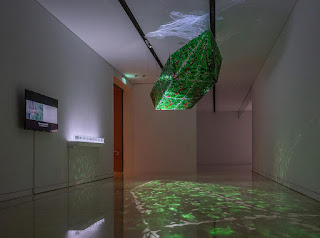 |
| 攝影:林律宏 Photographer: Harold Lin |
2025,水泥翻模 30x30x5cm x24, 鐵件(水谷藝術製作)280x175x45cm
Cement 30x30x5cm x24, steel structure( by Waley Art) dimensions variable
平常居住在萬里的排灣族藝術家張恩滿,在日常生活中便時常與北部不同的原住民族社群往來,聯絡感情的同時,也認識彼此的故事與日常。《植物誌轉印術》則是紀念著這些日常交往中隱含著的族群文化與記憶的裝置計劃。該計劃自2024年啟動,回應離散原住民族的文化記憶與文化延續性等議題,此次作品《植物誌轉印術—奇浩的文化記事簿》所聚焦的「奇浩部落」,是在1960年代自花蓮北漂來到基隆八尺門一代屯墾、生活的都市原住民阿美 族人們所凝聚的社區。藝術家以訪查與社區共創的創作過程中,將族人們日常中經常採集的植物來做拓印,在複刻植物美感自然生成的造型裡,並將這 些拓印的結果,組裝放置在每年七月會舉行豐年祭的觀海平台,象徵著聯繫族人與海另一邊的祖靈們之間的文化記憶。(文|陳晞)
Chang En-Man is a Paiwan artist who lives in Wanli and often visits different indigenous communities in nor thern Taiwan. These daily interactions strengthen emotional bonds and deepen her understanding of their stories and daily lives. Botanical Transfer Artistr y is an installation project that commemorates the cultural heritage and memories embedded in these exchanges. Launched in 2024, the project addresses issues of cultural memory and continuity for diaspora Indigenous communities. This specific work, Botanical Transfer Artistr y — Cultural Field Notes of Kihaw, which focuses on the Kihaw Tribe. The Kihaw Tribe comprises Amis urban Indigenous people who migrated north from Hualien in the 1960s to settle in the Bachimen area of Keelung. Through a creative process involving interviews and community collaboration, Chang uses plants that community members regularly gather for rubbing and imprinting. These imprints reproduce the plants' natural beauty. These imprints are then assembled and placed on the observation deck where the annual harvest festival is held every July. This installation symbolises the cultural memory that connects tribe members with their ancestral spirits across the sea. (Text by CHEN HSI )



















